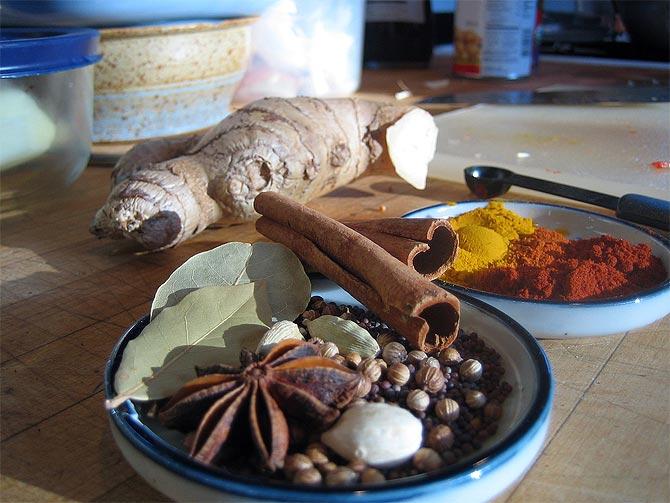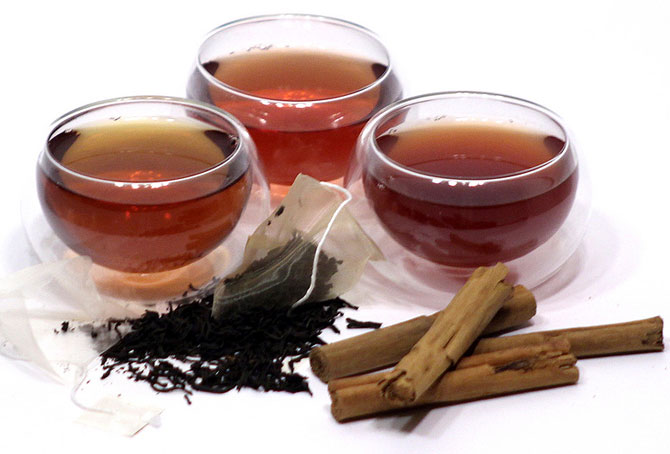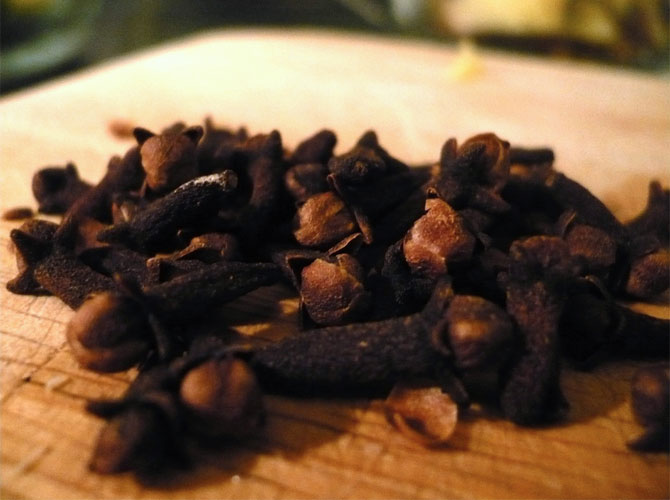Photographs: Erika dot net/Creative Commons Shameem Akhtar
A yogacharya trained with the Sivananda Yoga Vedanta Centre, Shameem Akthar lists out the benefits of five easily available kitchen ingredients.
Home remedies are the flavour of the season.
Our grandmothers and mothers believed in them.
Now, these once-forgotten remedies are making a comeback. Both in India, and across the world, people are looking towards the kitchen to sort out nagging physical problems.
The kitchen offers amazingly simple cures to problems that need not always be sorted by popping pills. This includes insomnia (in Western countries, sniffing lavender oil does the trick while, back home, a ripe yellow plantain sprinkled with roasted cumin seeds works better than counting sheep).
Earlier, these simple kitchen solutions would be confined to the region of their origin. Today, thanks to the easy availability of information, kitchen remedies from one region can be used in the opposite corner of the world.
It must also be remembered that, since natural remedies are rather powerful, their side-effects can also be disturbing.
While self-prescription would be foolhardy, this kind of easy access to information offers options that can be considered after checking out various sources for hidden contraindications that may not quite be known or shared by an over-enthusiastic site.
For instance, while nutmeg is often used (in negligible amounts, less than a pinch at a time) as an aphrodisiac in India, too much of it (in the hopes of enhancing one's performance) could be dangerous, since it could cause seizures or fits. Nutmeg is a nervine herb; it impacts your nervous system.
Do ensure, however, that you carefully check the drawbacks of misusing these simple remedies.
Turmeric
Photographs: Steve Jackson/Creative Commons Shameem Akhtar
Turmeric is often regarded as the yoga herb because it can improve flexibility and help heal joint inflammation.
There has been some drama around this root, when it was sought to be patented by a US firm, but the issue has since been resolved.
In the south, even today, raw haldi paste is rubbed on the skin to remove suntan, prevent sunburn and reduce UV damage.
Raw turmeric tubers are rubbed on a grating stone to create a paste that is used as poultice over wounds because of its anti-bacterial properties.
This paste is also used as fomentation over inflamed or swollen joints, as it is believed to relieve pain and swelling.
It stops bleeding when applied over wounds. This is why it is used over fresh body piercings, to initiate faster healing and avoid the formation of pus.
It is seen as a beauty accessory -- to remove hair, prevent and control skin eruptions, deal with skin infections and reduce scars.
It is used to relieve most respiratory system ailments, including asthma, sore throat and common cough.
It is used to relieve tooth pain and dental problems and control digestive tract issues (including flatulence). It can destroy worms and relieve uro-genital problems, including performance issues.
It is an ENT specialist; it can deal with problems dealing with the eyes, nose and throat.
Several books have been written about the magical properties of haldi (turmeric).
Does it make you wonder if it is time to visit your kitchen cabinet instead of the doctor's clinic?
Mint
Photographs: Darya Pino, Summer Tomato/Creative Commons Shameem Akhtar
Our very own humble pudina that we love in our food because of its spunky fragrance and flavour is a little medicine cabinet by itself!
According to the book Home Remedies by Swami Sivananda (Rs 100, by Divine Life Society), it is an 'astringent, refrigerant (meaning cooling), diuretic stimulant (causes increased passing of urine)' and has 'carminative (one that relieves flatulence) anti-spasmodic' properties.
It is used to control nausea, improve appetite and can be chewed as a natural mouth freshener.
Using a mint poultice (translated as 'lep' in Hindi) around your forehead can get rid of a headache.
Used as tea (with its leaves steeped in hot water), it can help with digestion. It helps control flatulence, either in oil form externally, or taken internally.
It can cool off high fever, relieve stomach ache and aid recovery from jaundice.
It is used to treat menstrual problems.
Cinnamon
Photographs: Cinnamon Vogue/Creative Commons Shameem Akhtar
Cinnamon tea can help contain nausea, and other digestive tract problems.
It is also used to add a dash of sweetness where white sugar may not be used, as with diabetes.
It is one of the best ways to remove fungal infections.
Even wooden shelves or products which tend to get covered fungus in post-monsoon humidity may be rubbed with cotton wool dipped in cinnamon oil.
This will remove the ugly white fungal coating permanently.
It is used to relieve bad breath or halitosis.
Cinnamon bark, rubbed with lime, can be applied on skin eruptions for relief.
Cinnamon gargle or tea can help clear mucous overload at throat or relieve the sinus too.
It is used to treat uro-genital problems, especially in women.
It can help control respiratory tract issues.
It can be used to relieve loose motions.
Swami Sivananda writes that it is a good substitute or partner with clove.
It has aphrodisiac properties. This means it can relieve depression and give you a high.
Cloves
Photographs: Craig Hermann/Creative Commons Shameem Akhtar
Widely used in cooking, it has tremendous powers to help the digestive tract.
It encourages the flow of natural digestive enzymes to complete our ritual of eating and absorption of nutrients from what we eat.
It is regarded as anti-flatulent, which explains its wide use post-meal, either in a paan (betel leaf) or as post-meal mouth freshener.
It is used to relieve a bad throat, control coughing and relieve congestion.
It is used to soothe the throat and thus sweeten the voice.
It can relieve nausea and control vomiting.
It is traditionally used widely in dental problems, including controlling toothache.
One of its few unknown properties is that it can quench thirst!
It is an ideal retort to acidity.
Its powers to boost immunity are believed to be magical.
It has the natural strength to eject parasites when taken as tea, steeped in water.
It is used as relief in pneumonia, high fevers and other inflammatory conditions, including mouth ulcers.
Coriander
Photographs: Kattebelletje/Creative Commons Shameem Akhtar
A little-known property of this commonly used spice is that it can help control modern day ailments like anorexia and bulimia.
It revives interest in food, according to Swami Sivananda.
It is said to improve male sexual vitality and tone the uro-genital system in general.
In its raw form (as a leaf) it can be used a poultice to relieve pain and inflammation.
Coriander tea/ concoction is said to help control piles. It has a tremendous impact on the digestive tract and can control most problems related to it.
It can control weakness, fainting, relieve chronic headache (when applied as paste at the forehead) and relieve inflammatory conditions like ulcers and boils.







Comment
article